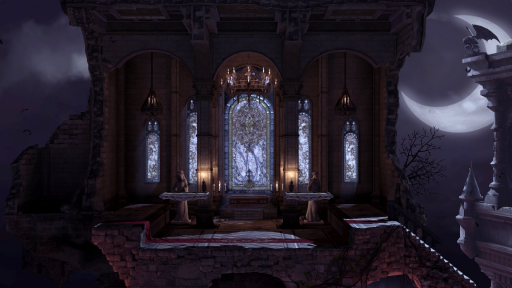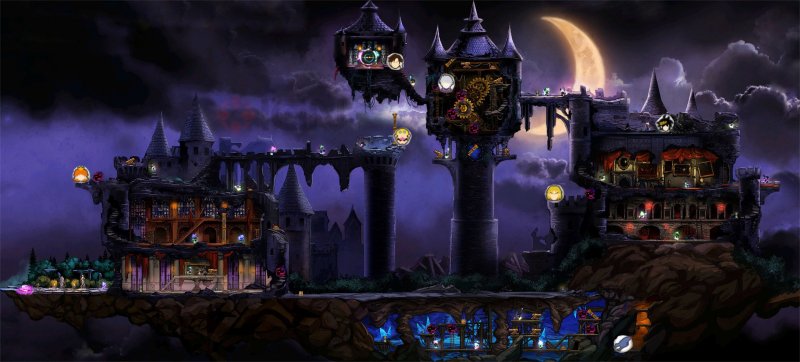
![]() Spotlight Stealers
Spotlight Stealers ![]()
![]()
|
Select Your Page
|
[Hai no Majutsushi] [Konami Wai Wai World] [Wai Wai World 2] [Kid Dracula] [Ganbare Goemon 2] [Gokujou Parodius] [Battle Tryst] [Konami Krazy Racers] [DMTV: World Fighters] [Konami WaiWai Sokoban] [Eternal Knights 2] [New International Track and Field] [THE-BishiBashi] [Hirameki Pazuru Makkusuueru no Fushigina Nohto] [Orecabattle] [Super Smash Bros. Ultimate]
[Castlevania References] [Borrowed Elements]
![]()
 |
Date Released
|
System
For
|
Romset
Size
|
|
7/29/2009
|
Arcade
|
Unknown
|
|
|
Main
Heroes
|
Scans
|
||
|
Konami
Mascots
|
None Available
|
||
|
Playable Castlevania
Villain: Death
|
|||
 |
|||
In addition to its acclaimed console titles, Konami is the creator of many longrunning arcade series aimed at communication and bringing people together for unique and engaging multiplayer experiences. Among them are its memorable rhythm games (like Dance Dance Revolution, GuitarFreaks and DrumMania, some of which are covered on these pages) and its mini-game-focused Bishi Bashi series, which has produced multiple sequels over its 15-year history. Always sticking closely to its familiar formula, the Bishi Bashi games (using up to two machines) pit 1-6 players--each choosing as an avatar one of Konami's colorful mascot characters--against each other in all sorts of battle-based mini-games. (Note: The three Bishi Bashi compilations ported to the original PlayStation have been modified to support 8 players, but this doesn't affect the core gameplay.) Using the control mechanisms available to all players (either a four-button setup entailing red, yellow, green and blue buttons; or peripherals like a steering wheel or the recognizable dance pad), arcade-goers compete by interacting with the buttons/peripherals as explained prior to a mini-game's start.


The culmination of the series is THE-BishiBashi, released in Japan in 2009. The premise hasn't changed, and the developers have played it safe, sticking purely to the four-button setup. Justifying its definitive title, then, is THE-BishiBashi 's cast of avatars, which is 50 strong; though, many of them are hidden, unlocked through the accumulation of points or the satisfying of certain conditions. Still, the cast's most notable members are there to be unlocked only by people who own a Konami "E-Amusement Pass," a special card that grants customers access to the company's online service for the purpose of recording scores, viewing ranking data, and downloading music. If a card-carrying customer has played Konami's recent arcade release Akumajou Dracula: The Arcade, having recorded any such data, he or she can then insert the card into the THE-BishiBashi cabinet and unlock a very prominent Castlevania character--the ubiquitous Death, appropriately miniaturized and ready to join the cast for some "mini"-game fun.


The contributor of this information, JPCVFAN, provides also this screenshot of Death being unlocked. There's no word at the moment as to any additional reward for unlocking him.
 |
Date Released
|
System
For
|
Rom Size
|
|
1/27/2011
|
Nintendo DS
|
32MB
|
|
|
Main
Hero
|
Scans
|
||
|
Maxwell
|
None Available
|
||
|
Conjurable Castlevania
Hero: Alucard
|
|||
|
|
|||
In the modern era of gaming--as defined by risk-averse companies who do as little as possible in flooding the market with sequels, remakes, and ever-derivative dreck--it's increasingly difficult to find genuinely new ideas. Should you make the effort to activate your inner radar, you might happen across a blip called Scribblenauts, a Nintendo DS-exclusive concoction brewed by the upstart studio 5th Cell; Scribblenauts drops you into a world where your imagination and depth of vocabulary are just as important as your platforming skills and reflexes. The game's main mechanic--a system that allows you to conjure up and put to use whatever items you so desire (sans vulgarity and copyrighted material)--is backed by a painstakingly populated, monstrous dictionary of words and terms, which you use to help the hero, Maxwell, collect the Starites found throughout a litany of stages. In short: Type an ojbect's name, it appears and functions in the expected way.


Anyone who understands the process of localization knows that its an arduous, often tedious process that results in certain territories receiving games late and sometimes not at all. Considering the large amount of language contained within Scribblenauts, it's no surprise that it took until early 2011 for it to arrive in Japan under a new name, translated roughly to Inspiration Puzzle Maxwell's Fantastic Notebook. Thanks to Konami, which agreed to publish the title on 5th Cell's behalf, Japanese gamers have since been joining in the fun. Regardless of culture, I have no doubt that any fan of Castlevania, or indeed any person currently reading this piece, has of course taken to conjuring up monsters, evils and beasties as encountered in Dracula's eerie domain. Scribblenauts has these in abundance, including such stalwarts as vampires, mummies, devils, demons, witches, zombies, skeletons, mermen, succubi, grim reapers, dragons, giant enemy crabs, and a whole slew of mythological, fictional and horror-based baddies; these fiends will happily tear Maxwell and each other apart should you choose to summon them.
Of course, should Maxwell need a little assistance in any such ill-conceived scenarios, he can happily beckon a small militia of vampire hunters and dhampirs, who will use their wooden stakes to assault and hopefully slay the vile creatures. The opportunity to contribute to the monster madness wasn't lost on Koji Igarashi (this version's producer), a master of this material who threw in a little Castlevania-related treat: Alucard, the half-breed son of Count Dracula. Call upon his troubled spirit and watch Alucard slice up the forces of darkness. (The Alucard images were supplied by JPCVFAN.)
 |
Date Released
|
System
For
|
Rom Size
|
|
3/14/2012
|
Arcade
|
Not Available
|
|
|
Main
Hero
|
Scans
|
||
|
Summoned
Heroes
|
None Available
|
||
|
Conjurable Castlevania
Hero: Alucard
|
|||
 |
|||
Monsuta Retsuden Orekabatoru (roughly translated to Monster Series of Biographies: Orecabattle) is another quirky Japan-only arcade title and an attempt to satiate the many players currently entrenched in the Monster Hunter madness. Orecabattle, simply, is a card-based game in which you summon heroes to battle monsters. After the machine scans your hero card (using its QR code), the game chooses a random enemy set and shifts play to the field of battle, where the encounter precipitates in RPG form; you then select from a list of commands and take down the enemies using the available options, the action unfolding via whacky, exaggerated scripted sequences.

Naturally, no large-scope Konami title would be complete without a cameo appearance by one of its established mascot characters. Batting DH, this time, is Alucard, who has all but usurped the Belmonts as the series' go-to ambassador. In addition to summoning Alucard, you can evolve the half-breed hero, Pokemon-style, into more powerful forms (all images and information courtesy of JPCVFAN):
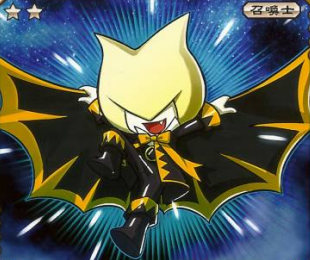 |
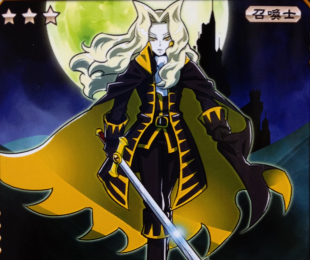 |
|
Initial form Aruka
(Aluca?) resembles Kid Dracula
|
Aruka grows into
a real live dhampir
|
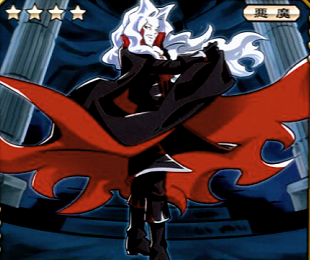 |
 |
|
Finally,
he becomes the Dark Lord, himself
|
Have
at you!
|
 |
Date Released
|
System
For
|
Rom Size
|
|
12/7/2018
|
Switch
|
13.6GB
|
|
|
Main
Fighters
|
Scans
|
||
|
Many Mascots
|
None Available
|
||
|
Playable Castlevania
Heroes: Simon and Richter
|
|||
After years of listening to us enthusiast types beg them for such, Masahiro Sakurai and Konami finally heeded our call and brought together the worlds of Castlevania and Super Smash Bros. And as the debut trailer revealed, they were inspired to deliver much more than what was commonly requested. To start, they introduce into the mix not only the legendary hero--the series' most iconic character--Simon Belmont but also Richter Belmont of Dracula X fame, the latter's inclusion, presumably, meant to attract the series fans who jumped onboard during the mid-90s. In Super Smash Bros. Ultimate, we can take either standout onto the battlefield and duke it out with dozens of other gaming legends (including Simon's old Captain N cohorts Pit and Mega Man) or even engage in an inter-Castlevania family feud! (Remember to click on images to view larger versions of them!)
 |
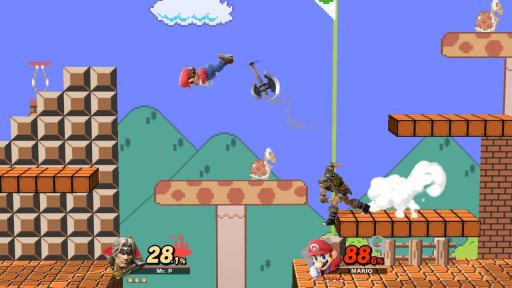 |
Simon and Richter's physical appearances and style of movement are based on those most associated with their traditional 8- and 16- bit games (the original Castlevania and Rondo of Blood, respectively). That's to say that their movement is sluggish, when either walking or running, and their jumps heavily lack for range and maneuverability; in terms of recovery, they find themselves on the lowest rung--among those whose options are highly inadequate. Though, as is true in their own games, this limitation is balanced out by a combination of considerable whip range and projectiles that cover a whole lot of ground; for this reason, they're considered masters of zoning (keeping opponents at a distance) and in skilled hands can exhibit a great degree of stage control. They're obnoxious like that.
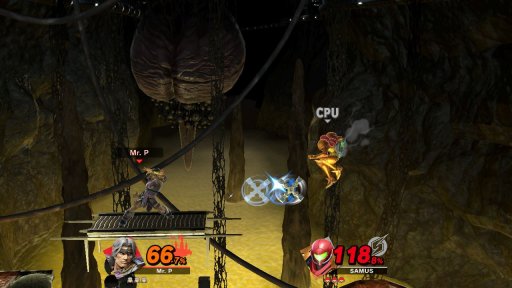 |
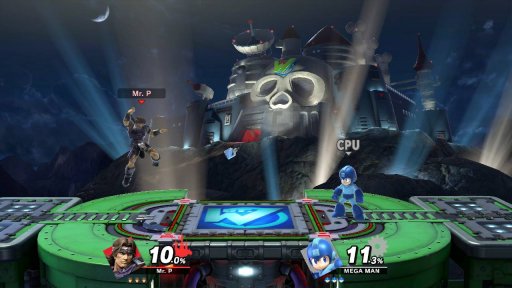 |
It should be said that Richter is an "Echo Fighter" (a new term for "clone) and altogether similar to Simon. Save for some differences in terms of animation, sub-weapon proprieties and personality (Simon is deathly serious whereas Richter is kind of goofy), they're functionally identical. All of their sideward and upward tilt and smash attacks are whip-slashes--the latter type naturally hitting with more range and punch--and they can exert influence to execute somewhat-angular, almost-diagonal slashes. Their sideward and upward aerial moves, too, are whip-slashes; while off-stage, they can use the forward-facing type to tether to the stage's edge (a clear reference to Super Castlevania IV Simon's and John Morris' whip-latching abilities). The tether allows them to recover from great distances and covers for their jumping deficiency, yes, but its active range is so indiscernible that the move simply can't be relied upon. Also, while standing in place, they can brandish the whip Super Castlevania IV-style--use the whip to repel nearby foes and neutralize incoming projectiles. Predictably, their special moves entail the use of the familiar Belmont Clan sub-weapons: neutral-B for the arcing axe; side-B for the boomerang-like cross; and down-B for explosive, engulfing holy water vials (sadly, the dagger and stopwatch didn't make the cut). All three can appear onscreen simultaneously, though only one of each can be thrown at a time.
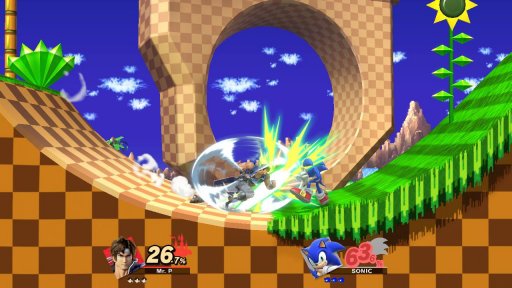 |
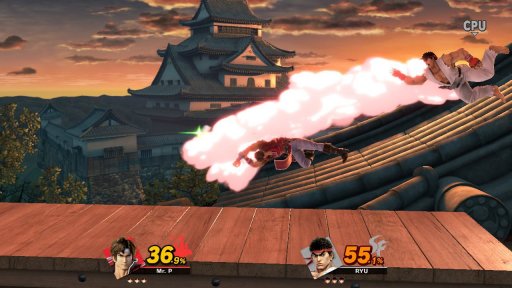 |
A couple of their attacks, you may notice, are taken directly from the moveset of Richter as he performed in Symphony of the Night's "Richter Mode." Their up-B attack/recovery move is the long-traveling Super Jump--the same uppercut-type maneuver that inflicted damage and allowed him greater accessibility. Their dash attack is the whip-twirling charge, which is a repurposed, grounded version of his horizontal air-dash. Their down-tilt is the very same two-step slide-to-vault kick. And their down-aerial attack is the diagonally-aimed darting jumpkick, which as it did previously allows them to strike at and rebound off of foes' heads and buy enough air to deliver follow-up attacks. All of their other moves are unique to Ultimate. This is true of their Final Smash, wherein they force one or multiple foes into a coffin, wrap the Vampire Killer around it, toss it high up into the air, and then destroy it with a cross-powered item-crash. Greeting them on the victory screen is the stage-clearing music from Castlevania and Rondo; it's there where either will strike one of his three victory poses (the most faithful of which is Simon's continually-jump-and-whip motion, which is a play on what he does in Castlevania if you hold the button down after collecting the stage-clearing orb) and let loose a verbal taunt.
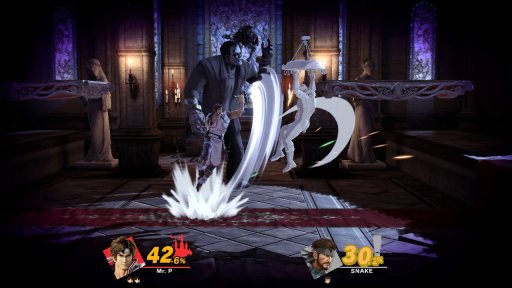 |
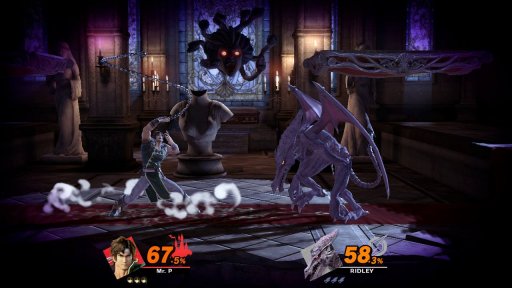 |
The second element is a Castlevania-themed stage. It's the Castle Keep into which you're bound to travel in just about every series game. Here, Dracula's dark, pillared domain is an island-type stage with two floating platforms placed in its middle. The left side's edge is a simple cliff while the right's is that classic lead-into staircase--a sloped surface off of which you'll drop if you walk too close to its bottom portion. If the camera pans out far enough, you'll even see the faithfully placed clock tower in the background! The stage's gimmick is purely a visual one: As you're battling it out, familiar series villains will regularly emerge in the keep's backdrop. Their group includes Medusa, who true to her first appearance breaks off from a levitating statue once it plants itself; the Mummy; the Creature (Frankenstein) and his Flea Man pal (not "Igor," as the character was originally identified); Death; Carmilla (in her Simon's Quest "Vampira" form); the Werewolf; and Kid Dracula, who appears only in silhouette form. They maneuver about for short periods, behaving in expected ways, and then unceremoniously depart. If hazards are turned on, you can whip the candelabras to get items (just don't expect to find any Castlevania-related items, since there are none). All the while, you'll enjoy the accompaniment of an original or remixed musical piece; we're talkin' 35 tracks worth of Castlevania tunes--over two hours of musical goodness. If you wish to listen to these tunes, click on the "Music Files" link below to zip over to the soundtrack page.
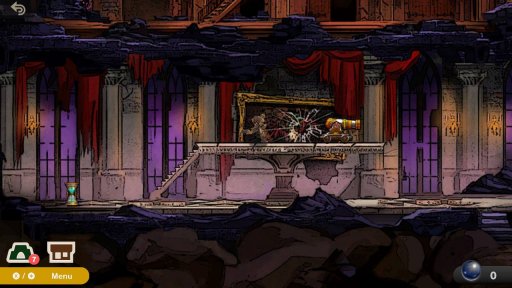 |
 |
Alucard also makes an appearance, though disappointingly not as a playable character (Sakurai felt that he wasn't popular enough to earn such status--a statement that serves either as a sign of ignorance or an excuse that he made up on the spot). Instead, he appears as an Assist Trophy. When summoned, he attacks opponents with some of his Symphony of the Night attacks: He uses the Crissaegrim to overwhelm them with a flurry of strikes. He violently flies into them using a bat dash. And he, too, executes a darting jumpkick.
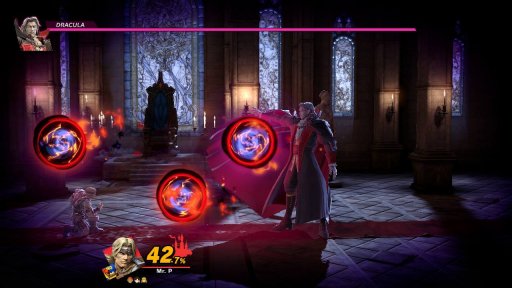 |
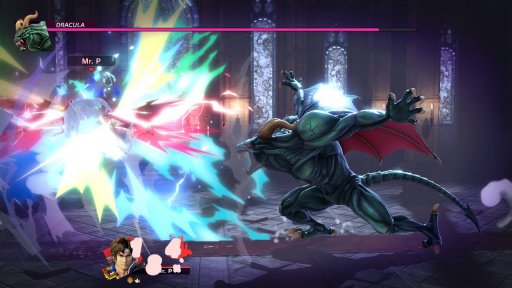 |
Castlevania also makes a big contribution to World of Light, the game's adventure mode. While traversing the Dark Realm's bottom-right portion, you'll discover one of its sub-worlds: Castlevania, whose level design is patterned after the map from the original Castlevania. Therein you'll fight your way through the main halls, the catacombs, the dungeon, the clock tower and other familiar environments and even solve some mechanism-based puzzles along the way (like, say, firing cannonballs into rotating planks in order to open blocked passageways). When you arrive at the keep, you'll tangle with Dracula in a Smash-style boss battle. His look is Symphony-themed, but his fighting style is based on what you remember from Rondo--the same two-phase battle. In the first phase, Dracula teleports about and executes one of five attacks: he releases three-directional fireballs; he fires a series of energy orbs that alternate between high and low; he commands three variably-spaced rising flame pillars; he releases two sets of rotating orbs; and he transforms into a swarm of bats and charges across the screen. You can damage him, and thus reduce his health meter, by striking him in the head. When the meter is depleted, he channels power and transforms into the big green horned devil ("Dracula's Ghost," as commonly termed). The frightening-looking menace jumps about, attempting to pounce on the hero. Intermittently it strikes with one of five attacks: It spews three-directional fireballs; it spits out enflamed skulls that arc upward before homing in on the target; it throws out cupped and overhead varieties of claw-swipes; it spits out a large blue energy blast; and it executes a high-jump whose impact sends damaging shockwaves far across the battlefield. Fortunately, the big guy is vulnerable everywhere, eliminating the need for precision strikes. Later on, this fight is recycled in a Boss Rush that occurs during the game's "True Ending" sequence.
Over the course of your experience (while you're playing through the adventure mode or engaging in other actives), you're likely to collect a number of series-related official-art renderings called "Spirits" (basically attribute-enhancing stickers that you can apply to your character in the adventure and normal Smash modes). There are sixteen in all. These depict all of the characters mentioned in this space plus those from other random series games: Trevor C. Belmont, Maria Renard (one as she appeared in Symphony and another as she appeared in the Rondo remake), Reinhardt Schneider, Nathan Graves, Hugh Baldwin, Juste Belmont, Yoko Belnades, Leon Belmont, Julius Belmont, Hector, Jonathan Morris, Charlotte Aulin, Shanoa, Gabriel Belmont, Shaft, and Soma Cruz.
Finally, you can play through Simon and Richter's specially tailored Classic Mode routes. Simon's is called "Smash-vania," wherein he takes on the roster's more-monstrous-looking members--anywhere from one to three of them at a time--and then aims to establish vampire-hunter supremacy by defeating Richter to a solo battle. At the route's end, he fights Dracula in the two-phase battle previously described. Richter's route is called "Smash Echoes," which pits him against fellow Echo Fighters like Dark Samus and Chrom; his route, too, culminates with that same Dracula battle.
Other Media
 |
|
Artwork credited
to SSBWiki.com
|
|
Official Art
|
Miscellaneous
|
||
| Simon Render | Mummy Render | ||
| Richter Render | The Creature Render | ||
| Dracula Render | Death Render | ||
| Dracula (Second Form) Render | Carmilla Render | ||
| Medusa Render | Werewolf Render | ||
Page 5: Castlevania References | Back
|
[Home] [What's New?] [CV Library] [Stages] [Reviews] [Weapons] [Castleography] [Multimedia] [Codes] [Links] |
||||




